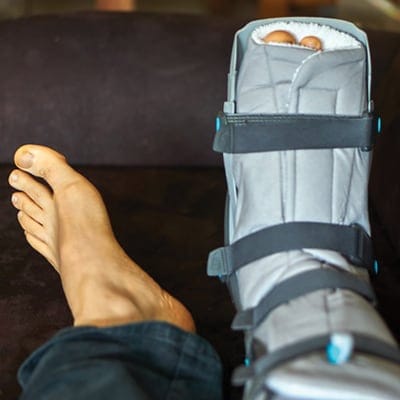Bunions are the painful result of too much pressure on your foot — like when you regularly wear shoes that are too small.
Your big toe bends or points toward your second toe. A bony bump, the bunion, forms at the base of your big toe and becomes sore, swollen and red. It can be hard to move your big toe or even the rest of your foot. And you may have trouble finding a shoe that fits over your deformity.
Bunions can lead to other issues too. Without proper treatment, you can develop arthritis, calluses, bone spurs, hammer toes or pain in the ball of your foot. Your big toe may push so far that it crosses over or underneath your other toes.
Before it gets to that point, you should get bunion surgery.
Bunion surgery gets to the root of the problem.
To fix the issue, you have to go to the source. Bunions form from the dislocation of the joint in your big toe and an imbalance in a hypermobile, and sometimes unstable, joint down in your midfoot. The dislocation forces the joint in your big toe to stick out and get bigger.
“Bunion surgery is recommended when pain and dysfunction begins to limit your activities, not simply because of appearance,” says Dr. Alivia Passet, foot and ankle surgeon at The Iowa Clinic.
A bunionectomy is a surgery that removes your bunion by restoring the big toe joint to its natural position. The foot and toe joints that led to the displacement are mended to bring more stability. In some cases, excess bone is removed.
Benefits of a Lapidus Bunionectomy
There are many types of bunion procedures, but the Lapidus bunionectomy is a tried-and-true approach to bunion correction. It’s the recommended procedure for moderate, large, severe and recurrent bunions. A Lapidus bunionectomy is the choice of experienced, board-certified foot and ankle surgeons because it:
- Corrects the deformity and gives your big toe a normal alignment.
- Preserves the function of your big toe.
- Stabilizes the midfoot by decreasing the hypermobility in those joints.
- Allows you to bear weight and begin walking sooner.
- Helps align and stabilize your ankle and heel.
Recovering from a Bunionectomy
A Lapidus bunionectomy gets you back on your feet sooner than other bunion procedures. As early as six weeks, you’ll be wearing normal shoes again and returning to your daily activities.
Get rid of your bunion, get rid of your pain.
Call 515.875.9876 to schedule an appointment with a podiatrist today.


